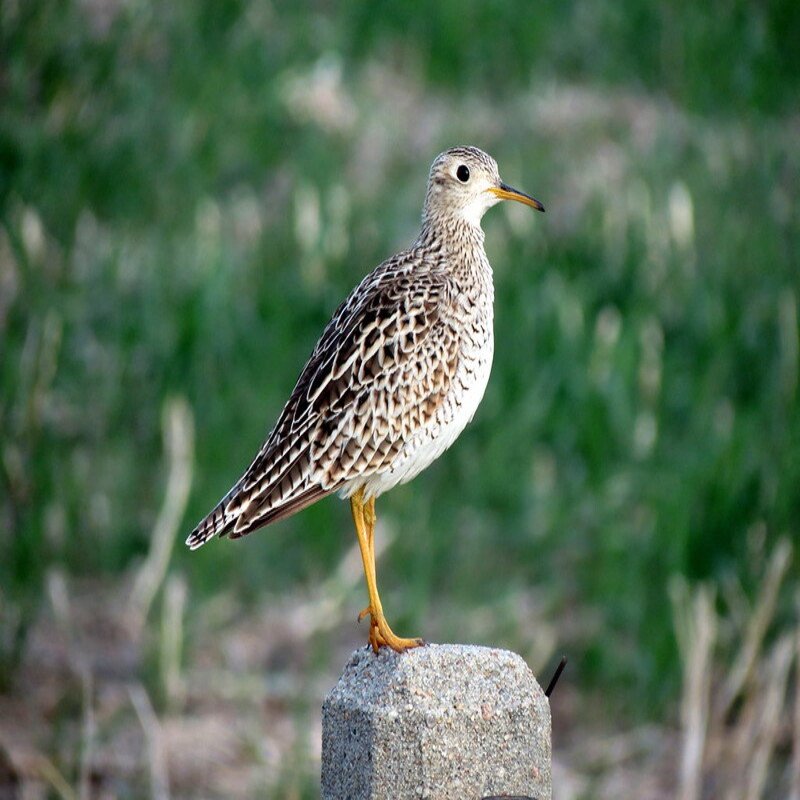Upland sandpipers (Bartramia longicauda) are huge sandpipers that are closely related to curlews. The upland plover and Bartram’s sandpiper are older names. It is also referred to colloquially as the papabotte in Louisiana. It is the sole species belonging to the genus Bartramia. Both the genus and the former popular name Bartram’s sandpiper are named in honor of the American naturalist William Bartram. Longicauda is derived from the Latin words longus, “long,” and caudus, “tail.”
Quick Overview: Bartramia Longicauda – Upland Sandpipers
Body size: Around 11-13 in (28-33 cm) and a weight of 136 g (4.8 oz)
Main colors: Brown, Black, White,
Range: Eastern United States
Migratory Bird: Yes
Best time of the year to see in the U.S.: March, April, May, September, October, November
Conservation Status: Least Concern
Upland Sandpipers Description
A large bird with dark speckled upperparts and a black rump. The chin, neck, and throat are all white. Dark chevrons run down the breasts and sides, with a white tummy. Cap is dark, with white eye-rings. The bill is slender, olive-brown, and decurved at the tip.

Size
These birds have a length of 11-13 in (28-33 cm) and a weight of 136 g (4.8 oz). Their wings could range from 17-20 in (43-51 cm).
Feeding
The grasshoppers, crickets, weevils, beetles, moths, ants, flies, bugs, centipedes, millipedes, spiders, snails, and earthworms comprise the food of the upland sandpiper.
Habitat
It is occasionally referred to as the “shorebird of the prairie.” It prefers open prairies, grasslands, pastures, wet meadows, and hayfields as habitats. Its population has dropped precipitously since the late 1800s as a result of hunting and habitat destruction.
Behavior
Upland sandpipers feed in fields, relying on sight to locate food. They are frequently observed perched atop fence posts and even telephone poles. When a “uppy” alights, it briefly holds its wings up. They continually scan the horizon for potential intruders.
Bartramia Longicauda Scientific Classification
- Kingdom: Animalia
- Phylum: Chordata
- Subphylum: Chelicerata
- Class: Aves
- Order: Charadriiformes
- Family: Scolopacidae
- Genus: Bartramia
- Species: Bartramia longicauda
Best time of the year to see
In the United States, the best time of year to see these birds are during the Spring season (March-May) and during the Autumn season (September – November).
Distribution of the Upland Sandpipers in the USA
Breeds from central Maine to Alaska, from the southeast to northern Oklahoma; and from the east to New England. Throughout the southern states during migration. Winters in southern Brazil and south-central Argentina.
The Upland Sandpipers can be found in the following states in the United States – Alabama, Arkansas, Colorado, Connecticut, Delaware, Florida, Georgia, Hawaii, Illinois, Indiana, Iowa, Kansas, Kentucky, Louisiana, Maryland, Massachusetts, Michigan, Minnesota, Mississippi, Missouri, Montana, Nebraska, New Hampshire, New Jersey, New Mexico, New York, North Carolina, North Dakota, Ohio, Pennsylvania, Rhode Island, South Carolina, South Dakota, Tennessee, Texas, Vermont, Virginia, West Virginia, Wisconsin, and Wyoming.
